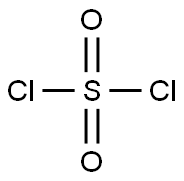-
外観
無色~うすい黄色, 澄明~ほとんど澄明の液体
-
性質
塩化スルフリルの融点は-54℃、沸点は69℃、密度は1.67g/cm3で、沸点より約30°C高い100°C以上に加熱すると分解します。
空気中でとへと分解されるため、古いサンプルは塩素の持つ色である黄緑色を帯びるようになります。
-
反応
塩化スルフリルは水と反応し、塩化水素ガスと硫酸を放出します 。
SO2Cl2 + 2H2O → 2HCl + H2SO4
塩化スルフリルは、過酸化物や光などによって開始されるアルカンの塩素化反応の塩素源として使用することができます。
CH4 + SO2Cl2 → CH3Cl + SO2 + HCl
-
溶解性
水と激しく反応。水に徐々に溶け、熱水には速やかにとけて硫酸及び塩酸を生じる。
-
解説
塩化スルフリル (英: Sulfuryl chloride) とは、常温常圧で辛みのある悪臭を有する無色の液体です。
化学式はSO2Cl2、分子量は134.97、CAS番号は7791-25-5の無機化合物です。硫黄原子を中心に2つの酸素原子と2つの塩素原子が結合した四面体構造を持ちます。
1838年にフランスの化学者アンリ・ヴィクトル・ルニョーによって初めて調製されました。
-
用途
有機合成用(塩素化剤及び酸無水物の製造)。
-
用途
クロロ化剤,酸無水物製造脱水剤(無水酢酸用),スルフォン化剤,溶剤,触媒
-
製法
活性炭などの触媒存在下で、二酸化硫黄と塩素を混合することによって得ることが可能です。化学式は以下です。
SO2 + Cl2 → SO2Cl2
生成物は蒸留によって精製でき、古くには、塩化チオニルを酸化することよって塩化スルフリルを合成していました。
SOCl2 + HgO → ClSSCl + HgCl2 + SO2Cl2
2SOCl2 + MnO2 → SO2 + MnCl2 + SO2Cl2
-
使用上の注意
空気中で発煙し、強い刺激臭がある。
-
化学的特性
colourless or pale yellow liquid
-
物理的性質
Colorless, mobile liquid; turns yellow on standing; very pungent odor; refractive index 1.4437 at 20°C; density 1.667 g/mL at 20°C; vapors heavier than air, vapor density 4.7 (air=1); melts at -51°C; boils at 69.4°C; sparingly soluble in water, decomposing slowly to sulfuric and hydrochloric acids; forms a hydrate SO2Cl2?15H2O with ice-cold water; miscible with benzene, toluene, chloroform, carbon tetrachloride, and glacial acetic acid; decomposed by alkalies (violent reaction occurs).
-
使用
Sulfuryl Chloride is a reagent used in the synthesis of catecholic flavonoids as telomerase inhibitors. It is also used to prepare (pyrenebutanamido)thiourea derivs. for anion PET chemosensors.
-
一般的な説明
A colorless fuming liquid with a pungent odor. Very toxic by inhalation. Corrosive to metals and tissue.
-
反応プロフィール
Sulfuryl chloride reacts exothermically with water. Incompatible with strong oxidizing agents, alcohols, amines. Reacts violently with bases. Attacks many metals. Can react explosively with lead dioxide [Mellor 10:676 1946-47]. May react vigorously or explosively if mixed with diisopropyl ether or other ethers in the presence of trace amounts of metal salts [J. Haz. Mat., 1981, 4, 291].
-
危険性
Strong irritant to tissue.
-
健康ハザード
Vapors cause severe irritation of eyes and respiratory system. Liquid burns eyes and skin. If ingested, can cause severe burns of mouth and stomach.
-
火災危険
Behavior in Fire: Toxic and irritating gases are generated.
-
法規情報
労働安全衛生法や化学物質排出把握管理促進法 (PRTR法)、毒物及び劇物取締法、消防法などいずれの主要な法令においても指定がありません。ただし、危険物船舶運送及び貯蔵規則においては「毒物類・毒物」、航空法では「輸送禁止」の物質に該当し、毒性を持ち催涙作用があるため、取り扱いには注意が必要です。
-
使用用途
塩化スルフリルは、放置するだけで塩素を発生させることができ、液体として保存することができるという特徴があるため、塩素の発生源として主に利用されています。カルボニルやスルホキシドなどの活性な置換基に隣接するC-HをC-Clへ変換する試薬として使用される他、アルカン、アルケン、アルキン、芳香族化合物、エーテル (テトラヒドロフランなど) およびエポキシドを塩素化します。
また、ベンジル位の炭化水素基を塩素化する際にも用いられます。
塩化スルフリルは、チオールまたはジスルフィドを対応する塩化スルフェニルに変換したり、アルコールを塩化アルキルに変換できます。
-
取扱いおよび保管上の注意
取扱い及び保管上の注意は、下記の通りです。
- 保管容器は不活性ガスを封入し、冷蔵庫 (2~10℃) で保管する。
- 屋外や換気の良い区域のみで使用する。
- 加水分解によって発生する塩化水素により、容器の内圧が高くなることがあるので、開栓する時は保護具を着用する。
- 使用時は保護手袋、保護眼鏡、保護衣、保護面を着用する。
- 激しく反応するため、アルカリ性物質、アルコール類および水との接触を避ける。
- 取扱い後はよく手を洗浄する。
- 吸入した場合、空気の新鮮な場所に移し、呼吸しやすい姿勢で休息させる。
- 皮膚に付着した場合は、すぐに多量の水と石鹸で洗い流す。
- 眼に入った場合は、水で数分間注意深く洗い、直ちに医師の手当てを受ける。
-
安全性プロファイル
A corrosive irritant to skin, eyes, and mucous membranes. Questionable carcinogen with experimental tumorigenic data. Can explode with Pb02. Will react with water or steam to produce heat and toxic and corrosive fumes. Incompatible with alkalies, diethyl ether, dimethyl sulfoxide,dinitrogen pentaoxide, lead dioxide, phosphorus. When heated to decomposition it emits highly toxic fumes of Cland SOx. See also SULFURIC ACID and HYDROCHLORIC ACID, which are formed upon hydrolysis.
-
職業ばく露
Sulfuryl chloride is used to make other chemicals, including chlorophenol and chlorothymol, disinfectants, pharmaceuticals, phosphate insecticides, heterocyclic herbicides, fungicides, dyestuffs, and some plastics; as a solvent and catalyst; as a chlorosulfonating agent in organic synthesis. Also used as a dehydrating agent, as cathode material and in lithium batteries; as a wool treatment to prevent shrinkage.
-
輸送方法
UN1834 Sulfuryl chloride, Hazard Class: 6.1; Labels: 6.1-Poison Inhalation Hazard; 8-Corrosive material; Inhalation Hazard Zone A. STN: 4930260; Sulfuryl chloride.
-
不和合性
Water and air reactive. When spilled in water, hydrogen chloride, sulfur dioxide and sulfuric acid are produced. Forms corrosive mixture with air (NFPA Fire Rating: 0). Reacts exothermically with moisture in air, water or steam, releasing heat and yielding sulfuric acid and HCl vapors. Reacts violently with bases, amines, amides, inorganic hydroxides; alkalis, alkali metals, dimethyl sulfoxide, dinitrogen pentoxide, lead dioxide (explosive reaction); N-methylformamide, red phosphorus. Reacts, possibly violently, with oxidizers, organic substances, strong acids, alcohols, amines, ethers e.g., diethyl ether, diisopropyl ether, especially if trace amounts of metal salts are present); glycols, peroxides. Attacks metals in the presence of moisture, forming flammable hydrogen gas. Acid formed by reaction with water can be neutralized by limestone, lime, or soda ash.
-
廃棄物の処理
Wear nitrile rubber gloves, laboratory coat, eye protection and, if necessary, a SCBA. Cover the spill with a 1:1:1 mixture by weight of sodium carbonate or calcium carbonate, clay cat litter (bentonite) and sand. When the sulfuryl chloride has been absorbed, scoop the mixture into a plastic pail of cold water. Allow to stand for 24 hours. Test the pH of the solution and neutralize if necessary with sodium carbonate. Decant the solution to the drain flushing with 50 times its volume of water. Treat the solid residue as normal refuse.


